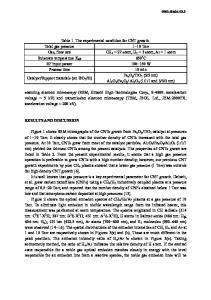Highly Ionized Carbon Plasma Generation by Dual-Laser Ablation for Diamond-Like Carbon Film Growth
- PDF / 394,773 Bytes
- 6 Pages / 414.72 x 648 pts Page_size
- 78 Downloads / 405 Views
HIGHLY IONIZED CARBON PLASMA GENERATION BY DUAL-LASER ABLATION FOR DIAMOND-LIKE CARBON FILM GROWTH S. WITANACHCHI, A. M. MIYAWA, AND P. MUKHERJEE Laboratory for Advanced Materials Science and Technology (LAMSAT), Department of Physics, University of South Florida, Tampa, FL 33620 ABSTRACT Carbon plasmas produced by excimer laser ablation show a low ionization yield of about 8-10%. The coupling of a second CO 2 laser pulse into the plasma in the dual-laser ablation process significantly increases the plasma temperature and the ionization. The resulting rapid expansion of the plasma gives rise to high ion kinetic energies and broader ion expansion profiles [1]. Optical emission spectroscopy and an ion probe have been used to investigate the dynamics of the carbon plasma. Single and dual-laser ablated carbon plumes have been deposited on DC-biased silicon substrates to form amorphous carbon films. The diamond-like behavior of these films was studied by Raman spectroscopy. The Raman spectra were deconvolved to gauge the effect of the density and the energy of ions on the formation of diamond-like sp-3 -bonded carbon (DLC) films. The advantage offered by the dual-laser process for the growth of DLC films is discussed. INTRODUCTION The unique properties offered by diamond, which include extreme hardness, high electrical resistivity, high dielectric strength, and high thermal conductivity, have motivated the deposition of diamond thin films for optical and electronic applications. Plasma enhanced chemical vapor deposition (CVD) is the most widely used technique for diamond film growth. Ion beam deposition, biased sputter deposition, and laser ablation are some of the alternative techniques used for the growth of diamond films[2-5]. These techniques can yield both crystalline and amorphous structures in which the properties of the films are determined by the nature of the atomic bonding. The three-fold coordinated (sp 2 ) bonding leads to graphitic behavior while four-fold coordinated (sp3) bonding leads to diamond-like characteristics. The amorphous network of carbon with approximately tetrahedral local atomic configuration exhibits diamond-like properties and is thus technologically important. The amorphous diamond-like carbon (DLC) films deposited by various techniques contain an atomically mixed structure of sp2 - and sp3 -bonded carbon. It has been shown that the metastable sp 3 hybridization of carbon is facilitated by the thermal agitation and shock wave accompanying ion bombardment on the depositing substrate[6]. Stabilization of the metastable atomic arrangement results from the high quenching rates associated with the rapid collapse of the thermal spikes produced by the ions[7]. Therefore, atomic agitation and rapid quenching caused by energetic species during deposition is important for the growth of DLC films. Carbon ionic energies in the range of 80-100 eV have been shown to produce DLC films with a high percentage of sp 3 hybridization[8]. However, much higher ionic energies cause displacement damage and surfa
Data Loading...











